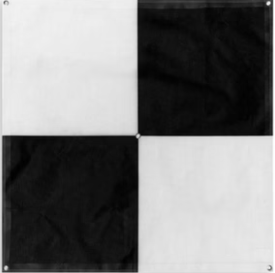Precision is the cornerstone of successful surveying, mapping, and aerial photography projects. Whether you are working on land development, construction planning, or environmental monitoring, achieving accurate data collection is essential. High-contrast targets have emerged as a simple yet highly effective tool to enhance survey precision and ensure reliable results.
What Are High-Contrast Targets?
High-contrast targets are visually distinct markers, typically designed with alternating black and white patterns. These targets are strategically placed on the ground or specific surfaces to serve as reference points for survey equipment, drones, and cameras. Their sharp color contrast ensures they are easily visible, even from high altitudes or in challenging lighting conditions.
The design of these targets often includes geometric shapes, such as checkerboards, circles, or crosshairs, which provide clear reference points for automated systems and software to identify and process.
The Importance of Precision in Surveying
Accurate data collection is vital in many industries. Errors in measurements can lead to costly mistakes, project delays, and inefficiencies. High-contrast targets address this issue by serving as fixed points that anchor data collection processes. Their visual clarity and distinct patterns allow for seamless integration into various surveying workflows.
How High-Contrast Targets Improve Survey Precision
Enhancing Visibility for Aerial Surveys
In aerial surveys, drones or aircraft equipped with cameras or LiDAR sensors capture vast areas of terrain. High-contrast targets placed strategically across the survey site act as visual anchors. Their distinct patterns are easily recognized by onboard sensors, enabling precise georeferencing of data.
This is particularly beneficial in environments with minimal natural reference points, such as deserts, forests, or urban areas with repetitive patterns. High-contrast targets ensure that even in these challenging scenarios, the survey data remains accurate and aligned.
Supporting Photogrammetry
Photogrammetry, the science of extracting measurements from photographs, requires high levels of precision. High-contrast targets serve as reference points that help align multiple images captured during the survey. Their distinct patterns ensure accurate stitching of images, resulting in detailed and precise 3D models.
By using high-contrast targets, surveyors can reduce errors caused by misaligned images, improving the overall quality and accuracy of their photogrammetry projects.
Improving Ground Control for UAV Mapping
Unmanned Aerial Vehicles (UAVs), or drones, have revolutionized surveying by enabling faster and more efficient data collection. However, achieving high precision with drones requires reliable ground control points (GCPs). High-contrast targets, often used as GCPs, provide an excellent solution for ensuring the accuracy of drone surveys.
These targets allow drones to identify exact reference points during data collection, improving the accuracy of geospatial data. They also simplify post-processing by providing clearly defined coordinates for alignment and calibration.
Enhancing Accuracy in LiDAR Surveys
LiDAR technology is widely used for creating detailed topographic maps and 3D models. High-contrast targets enhance LiDAR surveys by providing precise ground reference points. Their distinct patterns are easily detected by LiDAR sensors, ensuring accurate calibration and alignment of laser measurements.
This accuracy is particularly valuable in applications such as infrastructure development, environmental studies, and disaster management, where precision is critical.
Applications of High-Contrast Targets
High-contrast targets are versatile tools that can be used in various applications:
- Land Surveying: Improve accuracy in boundary mapping, topographic surveys, and property assessments.
- Construction Projects: Ensure precise placement of infrastructure and alignment of construction elements.
- Agriculture: Enhance data collection for crop monitoring, irrigation planning, and soil analysis.
- Environmental Monitoring: Track changes in ecosystems, forests, and water bodies with greater precision.
- Archaeological Studies: Map excavation sites and historical landmarks with accurate geospatial data.
- Disaster Management: Create detailed maps for disaster response and recovery efforts.
Advantages of Using High-Contrast Targets
- Cost-Effective: Simple design and materials make high-contrast targets an affordable solution.
- Easy Integration: Compatible with a wide range of surveying and mapping technologies.
- Enhanced Precision: Provides reliable reference points for accurate data collection.
- Versatility: Suitable for various applications across multiple industries.
- Improved Efficiency: Speeds up data collection and processing by reducing errors and the need for corrections.
Best Practices for Using High-Contrast Targets
To maximize the benefits of high-contrast targets, consider the following best practices:
- Strategic Placement: Position targets evenly across the survey area to ensure comprehensive coverage and alignment.
- Secure Installation: Anchor targets securely to prevent movement during data collection.
- Visibility: Ensure targets are clearly visible from the required altitude or distance.
- Calibration: Use accurate measuring tools to determine the exact coordinates of the targets.
- Regular Maintenance: Check for wear and tear, especially in outdoor environments, to maintain visibility.
Conclusion
High-contrast targets play a crucial role in enhancing survey precision across various industries. By providing clear and reliable reference points, these simple yet effective tools help surveyors achieve accurate and efficient data collection. From UAV mapping and photogrammetry to LiDAR surveys and construction planning, high-contrast targets are indispensable for ensuring reliable results.
For professionals seeking to improve their survey workflows, integrating high-contrast targets into their processes is a smart and practical solution. Accurate data leads to better decision-making, fewer errors, and more successful projects, making high-contrast targets an essential tool for modern surveying.
For more information visit: https://freearticlesmania.com/tech/
